|
Joseph Valachi was an American gangster who worked for the Genovese crime family, the oldest of the five families that once dominated organised crime in New York and New Jersey. In 1959, Valachi was convicted and sentenced to 15 years for drug trafficking and found himself incarcerated in the very same prison as his former boss, Vito Genovese, who was convinced that Valachi had betrayed him to the authorities. In 1962, he murdered a fellow inmate whom he believed had been sent by Genovese to kill him, and his sentence was extended to life imprisonment. The following year, he became the first member of the Italian-American Mafia to publicly acknowledge the organisation’s existence when he testified before a US Senate committee looking into organised crime. His televised testimony was the first major breach of the Mafia’s code of silence (or omertà) and he is credited with first popularising the term Cosa-Nostra. A biography of Valachi written by journalist Peter Maas that was drawn in part from Valachi’s own memoirs was published in 1968 under the title The Valachi Papers. The rights to the book were purchased by famed Italian producer Dino De Laurentiis, and in 1972 the film adaptation landed in cinemas. Despite Maas’s belief that Valachi should be played by Marlon Brando, De Laurentiis picked rising superstar Charles Bronson for the role.
The film opens as the middle-aged Valachi arrives at the prison in which Vito Genovese (Lino Ventura) is being held and is prevented from approaching his former Don. When he foils the aforementioned assassination attempt (here by three men) and later kills the wrong guy, he is finally granted an audience with Don Vito, who is unimpressed by Valachi’s insistence that he is not an informer and gives him the mafioso kiss of death, a curse that Valachi defiantly returns in kind. As far as I’m aware, this is the only time you’ll see Charles Bronson kiss another man in a movie. Convinced he is a dead man if he doesn’t take action, he agrees to go into protective custody and break the Mafia’s code of silence by revealing what he knows about the organisation and its dealings to investigating FBI agent Ryan (Gerald O'Loughlin).
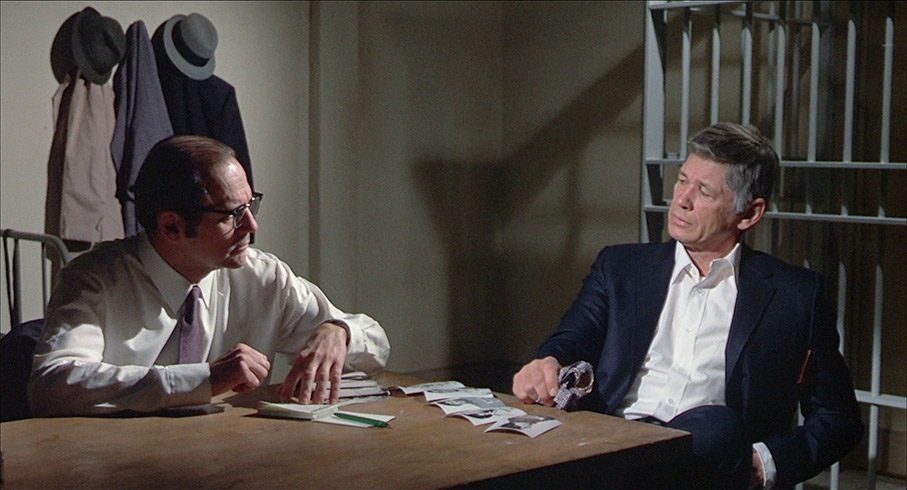
The story of Valachi’s mafia career then unfolds as a series of flashback stories related by Valachi to Ryan, an appropriate structure for a film based on a book that drew heavily on Valachi’s own unpublished memoirs. This does mean that Bronson is required to age a few decades during the course of the film, and this is the one area that you’ll have to cut the movie some slack. Bronson had one of those weather-beaten faces that probably never looked young even when he was in his teens, and despite some subtle prosthetics when he’s playing a man only a few years older than he was at the time, the key difference between the 20-something Valachi who first joins the mob and the 59-year-old man who testifies at the Justice Department hearing is that his initially black hair turns grey.
An almost text-book example of a solid and workmanlike film, The Valachi Papers ticks all the biographical gangster movie boxes without bringing that special something to the table that so distinguished The Godfather and its remarkable sequel. It’s efficiently and sometimes breezily directed by Terence Young (he of the early Bond movies) and an enjoyable cast is peppered with actors who really look the part, a handy offshoot of being an Italian co-production whose filming was split between New York and Rome. It’s worth noting that the match between the two shoots is largely seamless – it took this disc's commentary track to confirm when exteriors shot in one country cut to studio sets in another, and to even reveal which interior locations were Italian rather than American. It was also though the commentary that I learned how faithful to the facts the film manages to be for much of its running time, albeit with a few omissions and name-changes for legal reasons and a little artistic licence taken to add a some extra spice to scenes that for the most part would have worked fine without it.
Coming to The Valachi Papers just a days after covering Eureka’s Blu-ray release of Richard Fleischer’s The Don is Dead – another post-Godfather, mafia-themed gangster movie – also delivered a share of small surprises. Despite being released a year before Fleischer’s film, Young’s is considerably more violent (or should that be more bloody?) and includes a castration scene that, while not explicit (glad of that one, frankly), is still strong stuff for its day and apparently prompted its share of walk-outs on the film’s release. One of my few small gripes with The Don is Dead was that its three featured crime families felt as if they consisted of only a handful of men apiece, and that’s certainly not the case with The Valachi Papers. In an apparently faithful recreation of a banquet at which Don Salvatore Maranzano (Joseph Wiseman) addresses all of the New York families in his new role as the Boss of Bosses, the sheer number of attendees gives you an idea of the considerable size and reach the New York Mafia at the peak of its power. And while Scott Harrison, in his audio commentary on the Eureka disc, notes that some of the interior locations of The Don is Dead are more opulent than the post-Godfather norm, The Valachi Papers manages to outshine that film on this score, another advantage of shooting part of the film in Rome. If there’s a weakness here it’s that Valachi’s darker side has been swept under the carpet somewhat in service of a more sympathetic screen incarnation, and to avoid tarnishing the lead actor’s star image, of course. Here Valachi only kills once out of fear for his life and again later to put a horribly injured friend out of his misery, whereas the real Valachi carried out 33 mafia-ordered murders. I have a feeling it would take a filmmaker and lead actor of exceptional skill to sell that man to the paying public as a likable lead.
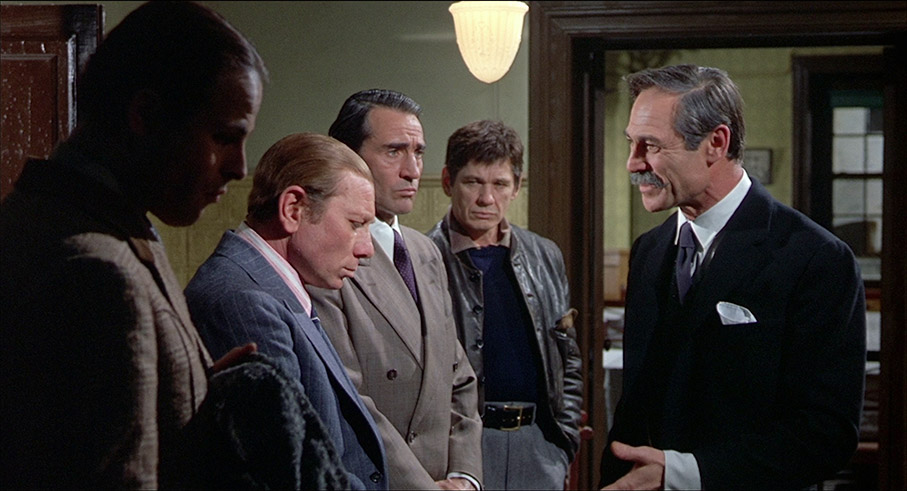
Whether Bronson is ideal casting as Valachi is up for a debate. He certainly has the right tough guy look and physique, but he’s not exactly a ringer for the man he is playing – my pick for the role would have been Lee J. Cobb, though the problem of de-aging him in this pre-digital age would have been no easier. That said, Bronson does a decent job here and is certainly chattier than his taciturn norm, though his finest moment is still a silent one, a look of convincingly painful anguish at the sight of the aforementioned castration. I will admit that I originally thought that Joseph Wiseman’s colourful Italian accent as Don Salvatore had a whiff of Super Mario about it, but once again the commentary track was on hand to put me straight, revealing that Wiseman had studied recordings of the real Salvatore Maranzano’s voice and speech patterns and had accurately reproduced them in the film. Lino Ventura makes for a suitably imposing Vito Genovese and several of his soldiers and compatriots are nicely cast and played, and few will be surprised to learn that Jill Ireland is on board as Valachi’s love interest, Maria, a role that was doubtless (mis-) cast at the insistence of her husband, Mr. Bronson.
I enjoyed The Valachi Papers but my appreciation of it definitely grew after delving into the true-life story on which it was based and discovering how closely the film adheres to the known facts. It moves at a steady lick, boasts a handful of standout scenes and even has short sequence involving noisy food that is actually quite funny, and although shot and released in the wake of the success of The Godfather, the film rights to Maas’s book were purchased by De Laurentiis before Coppola’s film went into production, so accusations of a cash-in are misplaced here (having said that, its release was bought forward to ride the Godfather wave). It’s an easy recommendation for fans of Bronson and true-life mafia movies, while its old-school rise and fall of a gangster structure would be lifted to even greater heights in the years that followed in films like Goodfellas, Scarface and Once Upon a Time in America. Watch it once for its fluidly efficient episodic storytelling and its entertainment value, then check out the excellent special features on this disc and give it a second look, and you’ll likely get even more out of it. I certainly did.
A clean and stable 1.85:1 1080p transfer with a warm colour palette, well-balanced contrast and solid but not over-aggressive black levels. Detail is good and sometimes really good, though there is a very slight softness to many shots that I’m guessing was part of the film’s period aesthetic and is certainly not an issue. There is one shot of Valachi driving that is almost soft enough to classify as out-of-focus – the slightly uncomfortable framing suggests a partial frame enlargement that I’m assuming was made at the editing stage. On the whole, though, a very sound transfer.
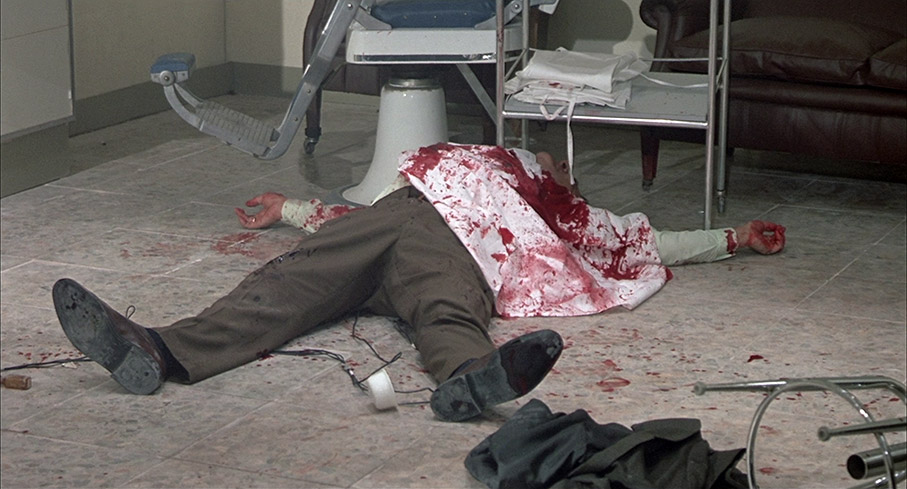
The Linear PCM 1.0 mono English language soundtrack has some noticeable restrictions in the dynamic range, but the dialogue is clear and the music and effects are cleanly reproduced with no trace of damage or wear.
Also included is an Italian dub, and while much of the English soundtrack was also post-dubbed – mostly (though not exclusively) by the actors themselves – the dubbing is far more obvious here, in the mismatch of mouth movements to the words being spoken and the fluffier quality of dialogue recording. It’s fun to watch Bronson dubbed into Italian, though.
Optional English subtitles for the deaf and hearing impaired are available, and optional English subtitles kick in by default on the Italian dub.
Audio Commentary with Paul Talbot
My usual process when covering discs is to complete my review of the film itself before watching the special features in order to better avoid being influenced by the views of others. However, a quick dip into this lively commentary by writer Paul Talbot – a Mafia historian and author of the books Bronson’s Loose! – The Making of the Death Wish Films and Bronson’s Loose Again! – On the Set With Charles Bronson – and I knew I’d need to pause my scribblings and give this a listen first. It turned out to be a shrewd move, as rather than offering his opinion of the film, Talbot focusses almost exclusively on providing detailed background information on everything from the actors and filmmakers to the guns and cars used, and most usefully the film’s treatment of the real-life case on which it was based. He highlights aspects that are accurately recreated and others that are the product of invention or interpretation, identifies actual Mafia figures who are absent or have had their names changed because they were still alive at the time of filming, and clarifies the reason for actions that you might not otherwise realise had meaning. Talbot talks at speed and with genuine enthusiasm for his subject, and there is a ton of information on the film, its makers, Valachi’s career and the key New York Mafia figures of the day. A superb companion to the film and an essential listen.
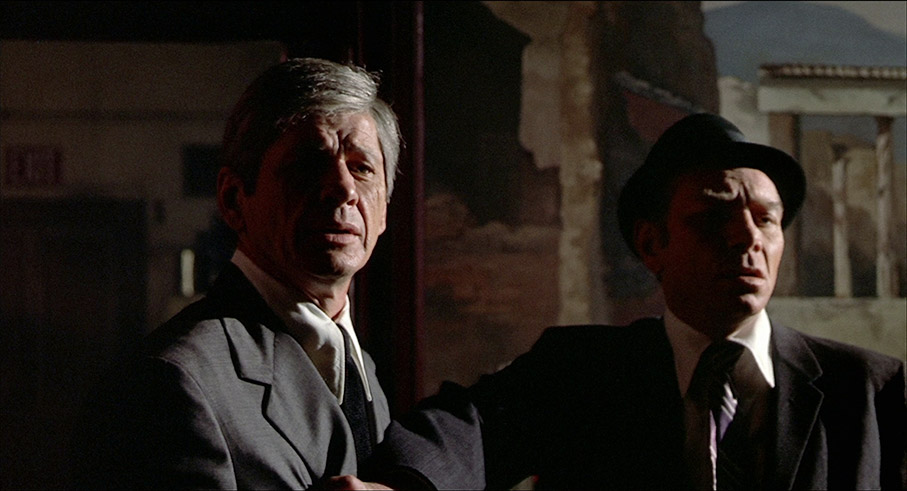
Giannetto De Rossi: In the Make-up Room (16:45)
The film’s Italian make-up artist, Giannetto De Rossi, recalls being hired to work on the film in part because producer Dino De Laurentiis needed someone who had experience working with Charles Bronson (De Rosssi had previously worked with Bronson on Once Upon a Time in the West) because “he knew how Bronson was,” then gives us an idea how difficult the actor could be before conversely describing him as “fantastic.” He briefly comments on some of the other performers in the film, tells a short but intriguing story of how spaghetti-loving cinematographer Aldo Tonti was once fired for using a piece of wood to judge light levels instead of a light meter, and recalls a conversation he had with a multiple-murderer when they were shooting on location in Sing Sing prison. When asked for his opinion on the film he intriguingly responds that it could have been better and that in his view director Terence Young wasn’t committed to the project.
Stephen Geller: Reviewing the Evidence (34:25)
Although 80 years of age, screenwriter Stephen Geller here has the energy and enthusiasm of a twenty-something enthusiast for his craft and proves to be a most engaging and animated storyteller. He’s also clearly someone who is used to saying what he thinks, which first becomes evident when he talks about a pivotal scene in the script that was missing from the movie and later when he passes negative comment on Terence Young’s direction, despite admitting that he really liked Young as a person. He tells entertaining stories about meeting mafioso Frank Costello and working with Bronson, and suggests at one point that he was the only person on the film who was ever straight with him. He clearly had a lot of time for the actor, but he remains unimpressed with the casting of the very English Jill Ireland as Valachi’s Italian-American wife Maria. He also confirms that Joseph Wiseman’s Italian accent was a spot-on recreation of Maranzano’s recorded voice.
Valachi: The Violent Era (6:32)
A featurette made during the film’s production that includes some behind-the-scenes footage that’s not in the following special feature, plus brief interviews in which Terence Young and Charles Bronson talk about Valachi and his criminal career.
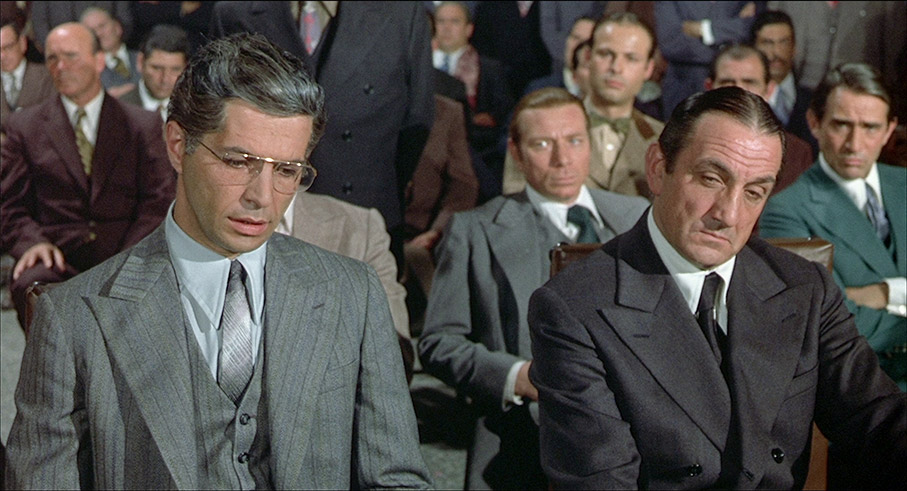
On-set Footage (2:01)
Just two minutes long and with washed-out colour, this brief peek behind the scenes during the filming of the banquet scene is still a valuable grab. We get to briefly glimpse Terence Young directing and witness Joseph Wiseman do a a bit of a Christian Bale and lose his cool mid-shot when his performance is disrupted by people talking off-set.
US Theatrical Trailer (3:22)
An unsurprisingly workmanlike and soberly narrated trailer that plays on the film’s based-on-fact credentials and includes plenty of violent action.
German Theatrical Trailer (3:34)
Essentially the same trailer but with German text, narration and dubbing of the actors and even of the real Valachi in footage from the Senate Hearing.
TV Spots (1:32)
Two cut-down and less violent edits of the theatrical trailer aimed at TV audiences.
Radio Spot (1:01)
A shorter, audio-only version of the theatrical trailer.
Image Gallery
85 screens of American and German promotional photos, scans of pages from the Japanese press book, record sleeves and international posters.
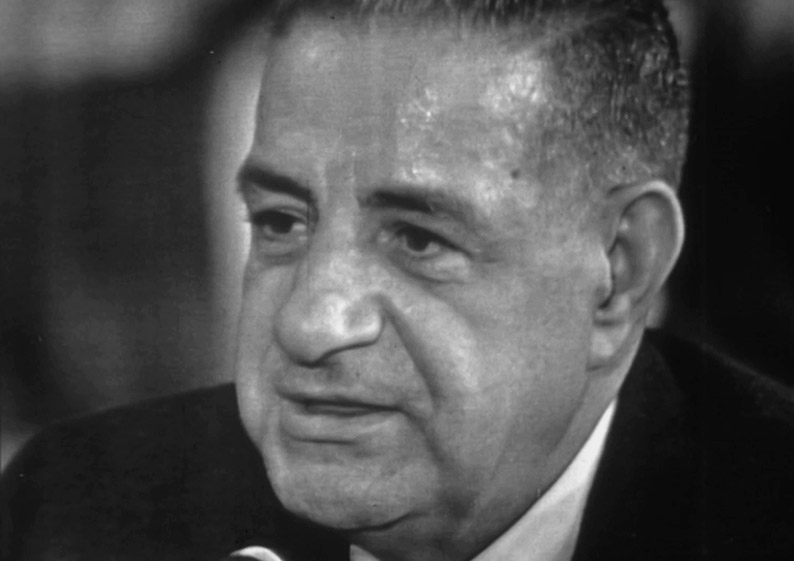
The Valachi Hearings (1963) (15:56)
Extracts from the real Valachi’s testimony before Arkansas Senator John L McClellan’s congressional committee on organised crime and the Permanent Subcommittee on Investigations of the US Subcommittee on Government Operations, which were broadcast in nightly news bulletins around America, which are subdivided into chaptered sections but can also be played as a single extra. Joseph Valachi Arrives at Capitol Hill (0:50) is what it says on the tin, being news footage of Valachi arriving at the hearing. In The Initiation Ceremony (4:16), Valachi describes the ceremony used to initiate him into the Cosa Nostra, a scene that is faithfully reproduced in the film. Frankly, it’s a miracle Valachi was able to finish a single sentence here, so often does the senator interrupt him and repeat what he just said. In The Banquet (5:51), Valachi recounts the speech delivered by Maranzano at the large meeting of families recreated in the film and discusses its purpose, with clarifying comments midway made by an unnamed presenter. In Narcotics and Killing (2:29), Valachi reveals how Chicago mobsters were paid a weekly bonus to shun the drug trade and talks about the killing of a mobster named Willie Morelli. Finally, in The Kiss of Death (2:37), he discusses the implications of being given the kiss of death by Don Vito Genovese. In all, a really welcome extra that allows us to see and hear the real Valachi confirm the accuracy of some aspects of the film’s portrayal of events.
Also included is a 36-page Booklet with a new essay by Pasquale Iannone, newspaper reports on Joseph Valachi’s criminal career, excerpts from the source book by Peter Maas, an overview of contemporary critical responses, and film credits. If I was sent a PDF of this, as I usually am, I must have somehow mislaid it, but I have no doubt it is up to Indicator’s usual high standard.
No classic, for sure, but a solid and entertaining crime biopic with an engaging cast and a surprising level of violence for a film of its day. It’s also closer to the known facts than I would have believed before watching and listening to the first-rate extras on this typically fine disc from Indicator. For genre fans and Bronson devotees especially, this has to come recommended.
|